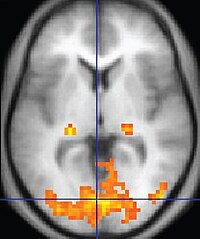
Photo from wikipedia
ETHNOPHARMACOLOGICAL RELEVANCE The herbs of Aconitum are the essential traditional Chinese medicine and have played an indispensable role in many Asian countries for thousands of years to treat critical illnesses,… Click to show full abstract
ETHNOPHARMACOLOGICAL RELEVANCE The herbs of Aconitum are the essential traditional Chinese medicine and have played an indispensable role in many Asian countries for thousands of years to treat critical illnesses, and chronic, stubborn diseases. However, Aconitum may result in severe neurotoxicity and even death. So far the mechanism of Aconitum across the blood-brain barrier (BBB) is still unclear. AIM OF THE STUDY To determine whether influx transporters contribute to the brain uptake of the highly toxic alkaloids in Aconitum including aconitine (AC), mesaconitine (MA) and hypaconitine (HA). MATERIALS AND METHODS The uptake of AC, MA and HA was characterized using in vitro hCMEC/D3 model and in situ mouse brain perfusion. In hCMEC/D3 cells, the effect of incubation temperature, time, initial drug concentration, energy (NaN3), extracellular and intracellular pH (FCCP and NH4Cl), the prototypical substrates/inhibitors of identified organic cation transporting carriers and trans-stimulation (pre-incubating with pyrilamine and diphenhydramine) on the cellular uptake were employed. In addition, the effect of silencing OCTN1, OCTN2 and PMAT by specific siRNA was investigated. In mice, the contribution of the proton-coupled antiporter on the brain uptake of Aconitum was investigated by chemical inhibition. RESULTS In hCMEC/D3 cells, AC, MA and HA were each taken up in a temperature-, time- and concentration-dependent manner, which were significantly reduced by NaN3 and FCCP. Regulation of extracellular and intracellular pH as well as trans-stimulation studies showed that AC, MA and HA were transported by a proton-coupled antiporter expressed at the plasma membrane that could also transport pyrilamine and diphenhydramine. Each uptake was markedly inhibited by various cationic drugs, but insensitive to the prototypical substrates/inhibitors of identified organic cation transporting carriers such as OCTs, PMAT, MATEs and OCTNs. In addition, silence of OCTN1, OCTN2 and PMAT by specific siRNA had no significant inhibitory effect on the uptake of AC, MA and HA. In mice, the brain uptake of each alkaloid measured by in situ brain perfusion was significantly suppressed by diphenhydramine when the transport capacity of P-gp/Bcrp at the BBB was chemically inhibited. CONCLUSIONS These results demonstrate that a novel proton-coupled organic cation antiporter plays a predominant role in the blood to brain influx of AC, MA and HA at the BBB, and thus affect the safety of Aconitum species.
Journal Title: Journal of ethnopharmacology
Year Published: 2020
Link to full text (if available)
Share on Social Media: Sign Up to like & get
recommendations!